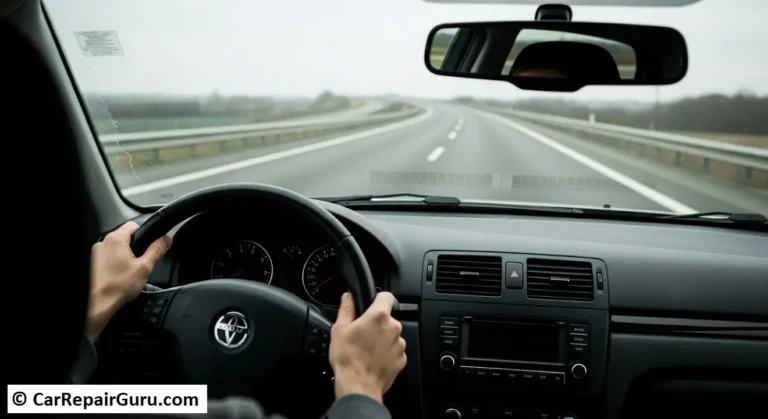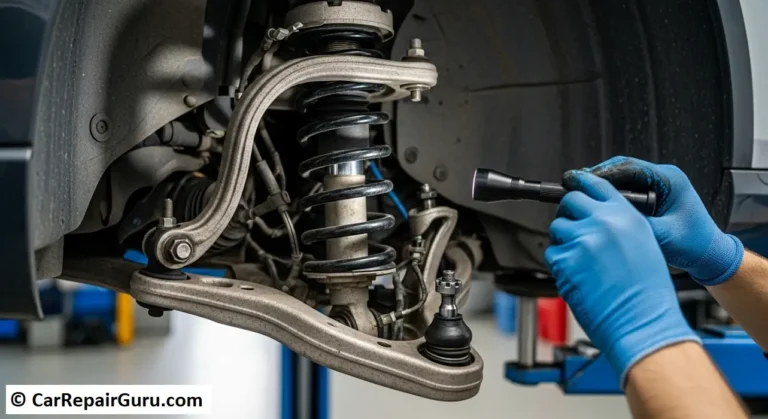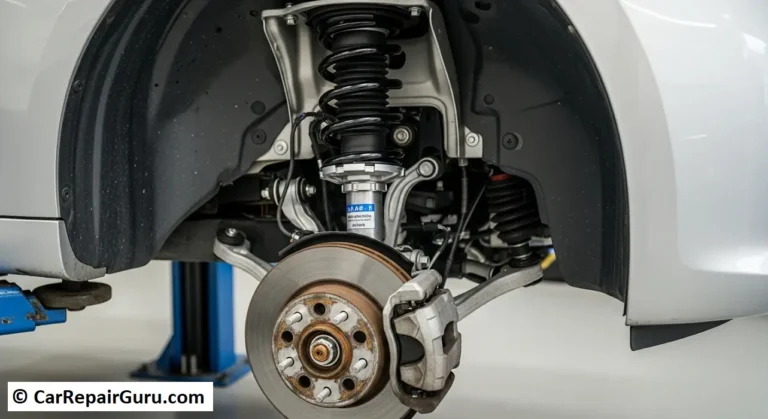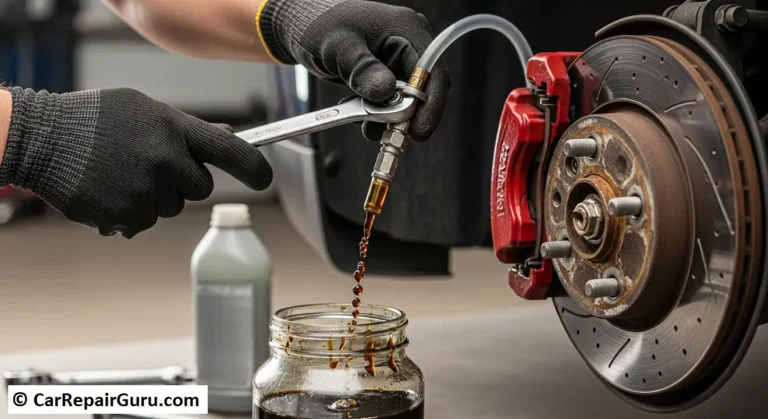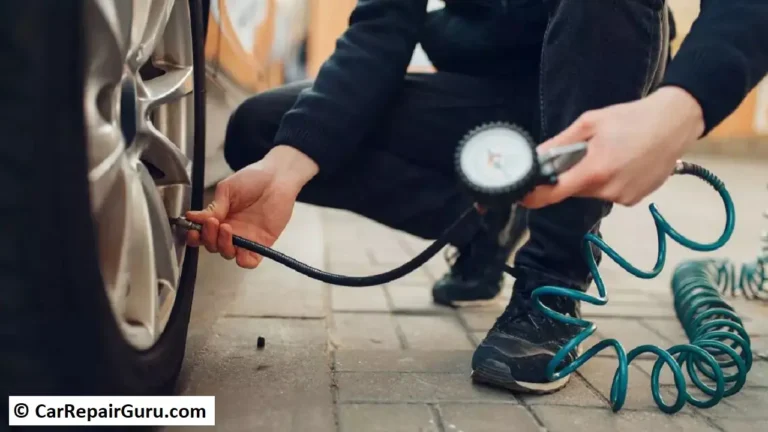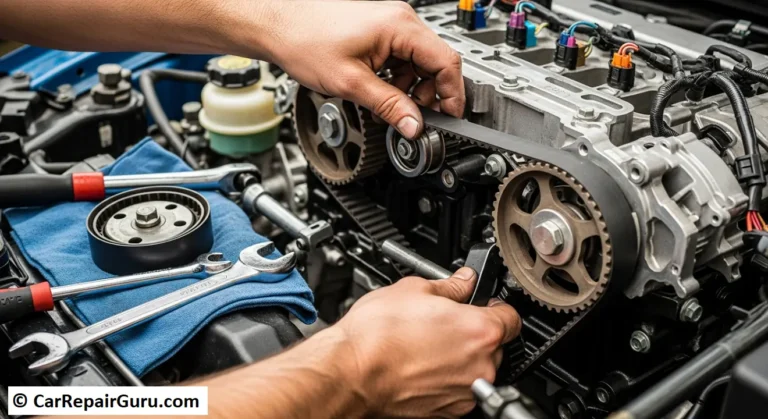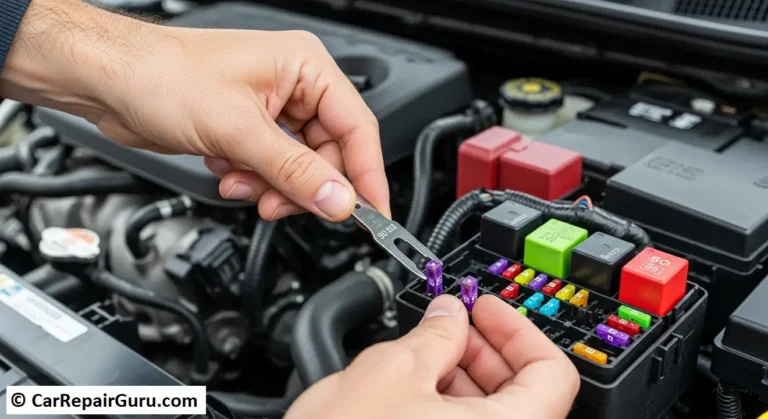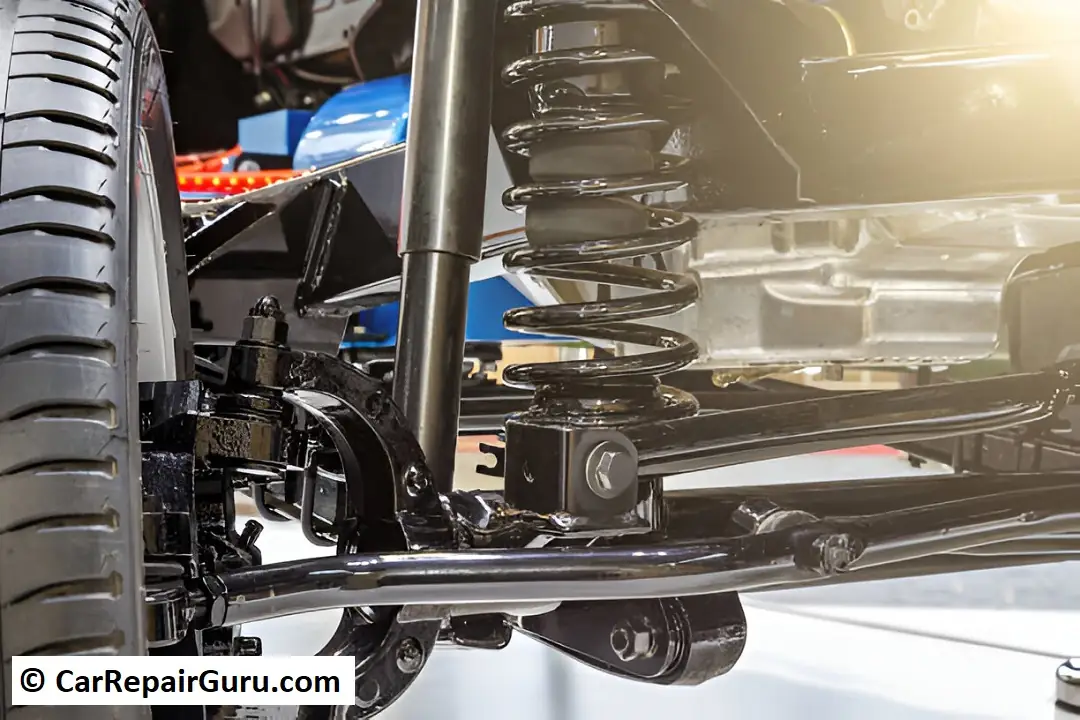
Your car’s suspension system is crucial for maintaining a harmonious balance between road handling and driving comfort. If you’ve been experiencing a ride that feels more like a rollercoaster lately, it’s time to check for signs of suspension failure and consider a car suspension repair.
Why is a healthy suspension system so important?
Beyond just smoothing out the bumps and vibrations from the road, your car suspension system controls a number of other vital aspects of your journey:
- Safety: A well-maintained suspension ensures optimal control during critical maneuvers like turning, emergency braking, and sudden maneuvers. It helps your tires stay glued to the road, providing the necessary traction for predictable steering and efficient braking.
- Stability: The suspension helps prevent rollovers, especially in vehicles with higher centers of gravity like SUVs and trucks. Some vehicles even feature adjustable suspension systems for varying ground clearance, beneficial for off-road driving conditions.
- Tire Longevity: A properly functioning suspension can extend the life of your tires and reduce the frequency of replacements by ensuring even tire wear.
6 Telltale Signs You Might Need Car Suspension Work:
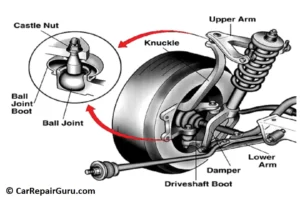
Because it’s safety-related, it’s essential to be aware of the warning signs of suspension problems if you want to continue driving safely and comfortably. Fortunately, you’ll likely notice or feel it when your car’s suspension starts to fail.
Keep an eye (and ear) out for these common indicators that your car’s suspension needs repair:
1. Uneven Tire Wear
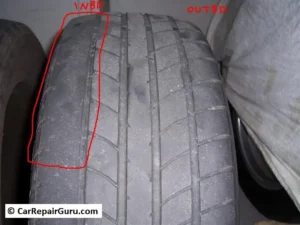
Your car suspension system is responsible for keeping your wheels and tires stable and in place, ensuring your car tires make proper contact with the pavement. Uneven tire wear can result from any part of the system wearing out, not being aligned correctly, or being unable to keep your tires straight.
It’s worth noting that a variety of factors can cause uneven tire wear. For instance, center wear is typically a result of overinflation, while inner and outer wear are more common in underinflated tires. However, if you notice “tire cupping,” you may have suspension problems. This is where sections of your car tires look like they’re wearing more than others due to the uneven wear. As a result, your car will likely start to vibrate while you’re driving as the problem is usually with your shocks or struts.
Besides a thorough visual inspection, here are other ways to detect uneven tire wear:
- Feel for it: Run your hands over the tire surface, checking for any irregularities in the tread, such as high or low areas.
- Measure Tread Depth: Use a tread depth gauge or a coin to measure the tread depth in different locations across the width of the tire.
- Pay Attention to Vibrations: If you experience unusual vibrations while driving, especially at higher speeds, it could be a sign of uneven tire wear.
Detecting uneven tire wear early and taking steps to address the underlying causes can make for a safer and more efficient driving experience.
2. Excessive Bouncing and Swaying
While not all bumpy rides indicate a problem with your car suspension system, this can be one of the initial indicators. You can distinguish minor road imperfections from those that point to more serious problems by paying attention to the symptoms and how your car responds to them.
For example, minor bumps in the road while driving normally are frequently caused by small potholes, cracks, or speed bumps. But with a faulty suspension system, even a minor bump in the road can cause your car to vibrate and your tires to momentarily lose contact with the pavement, but will soon regain traction. You typically won’t experience strange vibrations or hear many odd noises. You’ll be able to continue driving as if nothing happened even after running over minor bumps in the road because there won’t be any noticeable changes in the handling or steering response.
Bumps that point to more serious problems with your suspension system can be caused by large potholes or, you guessed it, worn suspension parts. “Problem bumps,” in contrast to minor bumps, are more likely to produce jarring and prolonged discomfort. They can be extremely unstable, shaky, and bouncy, making it more difficult to control your car. Additionally, if there is something wrong with the car suspension, the tires might not be able to fully regain traction after impact, which could impair the handling and steering response.
3. Nose Diving or Rear-End Squatting
“Nose diving,” in this case, refers to the front end of your vehicle dipping or “diving” forward excessively when you apply the brakes. Whereas “rear-end squats” occur when the rear of the vehicle dips downward, typically during acceleration or when the vehicle is carrying a heavy load.
Needless to say, both of these symptoms suggest a problem with your car’s suspension system and could be making you unsafe to drive. For instance, nose-diving can be a sign of worn-out brakes and poor braking performance, making it harder to stop the car safely.
Meanwhile, rear-end squatting can affect your vehicle’s traction and stability, especially at higher speeds, negatively impacting handling and grip. So have a professional immediately check your car suspension system if you detect either of these issues.
4. Pulling or Drifting
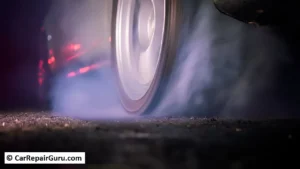
Pulling or drifting while driving is another telltale sign that your car needs suspension repair. While there are other potential causes, pulling and drifting often indicate handling issues that could stem from a faulty suspension system.
When your car drifts or floats without your control, it’s usually a sign of uneven tire wear or unbalanced wheels caused by worn suspension parts. Conversely, pulling occurs when the vehicle veers to one side, suggesting an alignment problem.
Take note of how your car handles on straight stretches of road to identify these problems. Typically, drivers will experience difficulties with steering and feel a lack of stability when their cars have a suspension problem. Besides being inconvenient and annoying, this puts everyone on the road, including your passengers, at risk.
As a result, it’s crucial to take prompt action to ensure safety and prevent further damage.
5. Leaking or Damaged Shocks and Struts
Worn or damaged shocks and struts are often the culprit behind a bumpy and uncomfortable ride. While you can’t generally see these suspension components on your car, you can (to some extent) inspect your shocks and struts yourself if you think there might be a problem.
You may need to look closely through the wheel well or underneath your car to access your shocks or struts, depending on the make and model of your vehicle. You can also jack up your car if necessary to get a better view.
Visually inspect the shocks or struts or feel for any signs of fluid leaks. If they appear oily or wet, they likely need to be replaced.
However, sometimes, especially in the case of internal problems, a visual inspection might not be enough to identify all potential issues. It’s best to take your car to a reputable mechanic for a thorough inspection and accurate diagnosis.
6. Clunking, Knocking, or Rattling Sounds
Another common sign that your car suspension is in trouble is the appearance of unusual noises. These sounds can manifest as clunking, banging, squeaking, or a general feeling of looseness, especially when driving over bumps or turning.
These noises can be attributed to several factors, including worn-out bushings, ball joints, or tie rod ends, indicating that your suspension components are struggling to do their job effectively. For instance, your suspension system’s control arms ensure that your car tires maintain full contact with the road while you’re driving. Keep in mind that your car suspension system needs to be repaired if you start to hear clunking or banging noises when accelerating, decelerating, or driving on uneven ground.
Worn ball joints, which connect various suspension parts – such as connecting the control arms to the steering knuckles or spindles – to ensure smooth and controlled wheel movement, are another prevalent issue. Ball joint damage can manifest in several ways, such as rust or torn boots, but it’s essential to address any symptoms you notice promptly, as they can worsen over time.
Besides worn shocks and damaged struts, loose hardware (such as improperly tightened suspension bolts) can also cause your car to make strange noises. One of the surest ways to prevent these problems is through routine maintenance.
Avoiding Car Suspension Problems Before They Start
One of the best ways to identify potential suspension problems, or any other noticeable issues with the car, before purchasing one is to take it for an extended test drive. It’s typically easy to recognize warning signs of a compromised car suspension system when you listen closely for any odd noises emanating from the suspension area, evaluate the car’s overall stability and ride comfort, look for signs of uneven tire wear, or determine potential braking issues. Ultimately, accidents can occur from a loss of control while driving.
Repairing Your Car’s Suspension
Regularly servicing your suspension is essential to prevent future problems, and a trained mechanic should inspect it every 40,000 to 50,000 kilometers.
Damaged suspension parts must be replaced immediately, and you should avoid driving fast on uneven roads and keep your tires properly inflated.
Repairing your car’s suspension depends on the type of problem. Generally, the steps involved in a suspension repair include:
- Diagnosing the Problem: The first step is to accurately identify the problem. This can be done by having a qualified mechanic inspect the suspension or by observing the signs of damage previously mentioned.
- Replacing Damaged Parts: Once the problem is identified, the damaged parts must be replaced with new ones. Commonly replaced parts include:
- Springs
- Shocks and struts
- Control arms
- Sway bar links
- Stabilizer bar bushings
It is important to use high-quality replacement parts that are compatible with the make and model of your vehicle.
- Wheel Alignment: After the damaged parts have been replaced, the wheels must be aligned to ensure they are pointing in the right direction. This helps to ensure that the vehicle tracks straight and handles properly.
- Test Drive: Finally, the vehicle should be test driven to ensure that the suspension is working properly.
The cost of suspension repair will vary depending on the type of problem, the make and model of the vehicle, and the labor rates in your area. It is always a good idea to get quotes from several mechanics before having any work done.
FAQs About Car Suspension
Q: How often should I get my suspension checked?
A: It’s generally recommended to have your car’s suspension inspected every 1-2 years or every 20,000-30,000 miles, even if you don’t notice any problems. Regular checks can catch issues early, saving you from costly repairs down the line.
Q: Can I drive with a bad suspension?
A: While it may be possible to drive short distances with a worn suspension component, it’s highly discouraged. A compromised suspension system significantly affects your safety, control, and tire wear, putting you and others at risk.
Q: How much does it cost to fix a car suspension?
A: Costs vary widely depending on the extent of the damage, the type of vehicle, and local labor rates. Simple repairs like replacing a sway bar link might cost a few hundred dollars, while a complete suspension overhaul could run into the thousands.
Q: What are the most common causes of suspension problems?
A: Common causes include wear and tear from regular use, exposure to rough roads, and inadequate maintenance. Regular inspections can help you identify these issues before they escalate.
Q: How can I tell if my suspension needs repair?
A: Look out for signs like excessive bouncing, pulling to one side, or unusual noises when driving. If you notice these symptoms, it’s crucial to get your suspension checked by a professional.
Q: Can I inspect my suspension myself?
A: While some basic checks can be done at home, such as looking for leaks in shocks and struts or checking for uneven tire wear, it’s best to have a qualified mechanic conduct a thorough inspection for safety and accuracy.
Key Points & Tips
- Listen to Your Car: Pay attention to any new noises, vibrations, or changes in handling. Consider keeping a log of any unusual sounds.
- Check Your Tires Regularly: Inspect your tires at least once a month for signs of uneven wear and proper inflation.
- Don’t Ignore the Problem: If you notice any warning signs, seek a professional inspection as soon as possible to avoid costly repairs.
Final Thoughts
Your car’s suspension system is vital for safety, comfort, and overall vehicle performance. By being aware of common warning signs and understanding the importance of regular maintenance, you can help ensure a smooth, controlled, and safe driving experience. If you suspect any issues with your suspension system, don’t hesitate to consult a qualified mechanic. Your peace of mind and safety are paramount.
Ready for a Smooth Ride?
Is your car exhibiting any of these warning signs? Don’t wait for a minor problem to escalate into a major safety hazard. Schedule a suspension inspection with your trusted mechanic today. Your safety and driving comfort are worth it.
